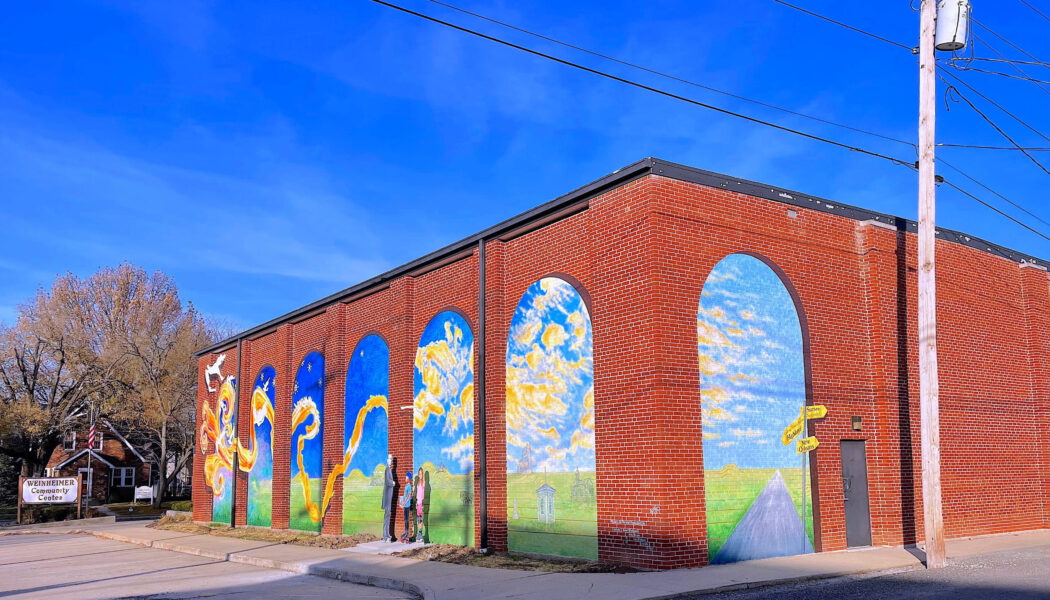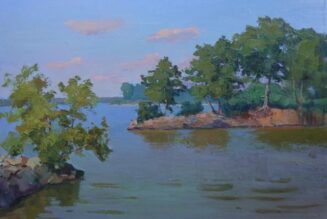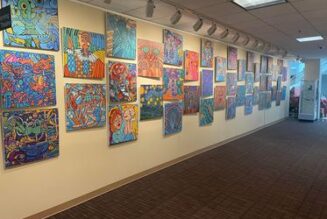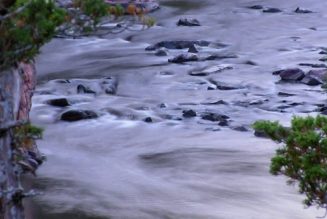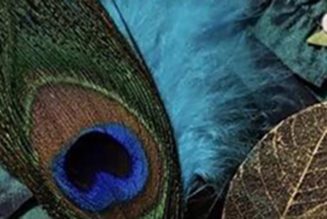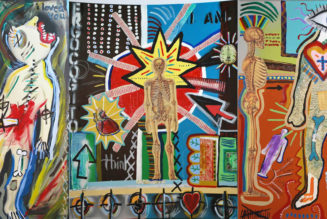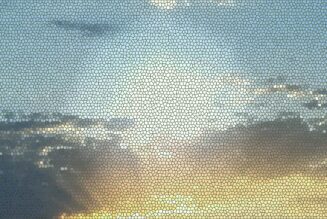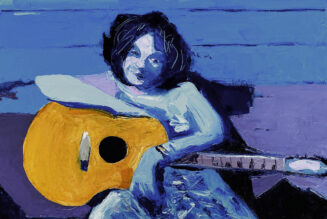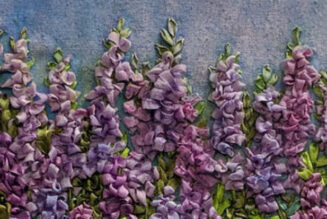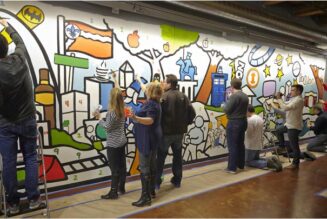Made possible in part by a $10,000 matching grant from the National Endowment for the Arts, a mural was designed and painted on the side of the Weinheimer Community Center at the corner of Main and Pine Streets in Highland, Illinois, by Robert and Liza Fishbone of On the Wall Productions from St. Louis, Missouri. They were assisted onsite by Andy Cross (set painter for The St. Louis Muny Opera), and Lisa Roth. Deborah “Moe” Moellering painted the three cut out figures installed next to the mural.
As one turns off Broadway onto Pine Street, an archway can be seen with a road and a set of directional street signs which read: “Highland/Looking Glass Prairie” on one, “Sursee, Switzerland” on another and “New Orleans” on the third. And so, our history lesson begins…
The first settlers of Highland came from Sursee, Switzerland, by boat into New York, up the Hudson River to Albany, by canal to Buffalo, then Lake Erie by steamboat to Cleveland, Ohio, by the Ohio canal to Dresden and then a flatboat down the Muskingum River to Marietta, and down the Ohio River to the Mississippi River and north to the St. Louis Area. The settlers wrote back to relatives following them that this way of traveling was most tedious, and they would find an easier path by going to the south entrance of the Mississippi River through New Orleans. Most of the settlers coming after that time, came through New Orleans.
The settlers from Switzerland named their town New Switzerland in 1831, but when it was platted in 1837, it was given the name Highland. During the year 1840, the postmaster was advised that Highland’s name should be changed to Helvetia since there was a town named Highland near Chicago. But because the Highland near Chicago was renamed Highland Park, Helvetia became Highland once more in 1843. Highland had many nicknames for various areas like Looking Glass Prairie. The farmers found that clearing the prairies covered in grass was easier to complete than clearing wooded areas before planting.
Turning the corner of the building, you will see representation of several icons of Highland’s history. The first schoolhouse was used as a church as well as a school, but it burned down in 1850. The German Evangelical Church, which had been using the schoolhouse for services, decided to build the “Stone Church” on Methodist Hill (Zschokke & 12th Streets) and is represented by the first icon on the mural.
The bell tower icon in the first arch to the left of the church represents the bell tower that was originally atop the first Highland City Hall. Keep an eye out for it because it is being revived and placed in the block east of the current City Hall, preserving some of Highland’s history in the new parking lot on Broadway. Jonathon Pierce, of Boy Scout Troup #8040 in Highland, is planning to build flower boxes to be placed around its base as part of his Eagle Scout Project.
To the left of the bell tower in the mural is the Bosshard Monument, which is currently in Lindendale Park. Heinrich Bosshard lived in Highland and was well-known in Switzerland for writing the poem “The Song of Sempach.” The poem, which is about the Battle of Sempach which gave Switzerland its independence from Austria on July 9, 1386, was set to music by J. V. Wehrle using the title “Sempacherlied.” Ultimately, the song became one of Switzerland’s anthems.
Higher on the mural is a representation of the Schott Brewery, which was established around 1887. After 100 years of playing an important part of life in Highland as a brewery, it succumbed to its competition after World War II. Many weddings and graduating seniors still use the front of the building as a backdrop for photos.
A horse and plow represent the first industry around Highland because early settlers needed to provide food for the family. Corn was an important crop for the initial settlers to provide grain for cornmeal to eat and to feed horses and livestock. Sheep provided wool for clothing, and livestock provided meat to sustain the family.
The dump truck represents the innovative mind of C. J. Hug who provided employment for many people throughout the years. After an eclectic career, he became a major builder for Pet Milk Company. For his business, he needed a type of truck that wasn’t available as yet, so he designed and built his own and turned that design into a thriving business building trucks for other companies. He invented the Hug Turntable, a unit that could turn around a truck loaded with concrete. In fact, his biggest contribution to the City was to hatch the idea of paving every street in Highland at the same time. The project began in 1928 and ended in 1929. The cost was $360,000 with the 3000 residents of Highland bearing the cost.
The railroad is represented because it arrived in 1867 bringing visitors to party on the weekends. Highland had more taverns than many surrounding cities, so it was the place to ride the rails into on Friday and back home on Sunday. While railroad builders and partiers were in the City, a business boom hit. Temporary jails were set up in what is now the Masonic Temple to house those that got out of hand.
The Weinheimer Community Center is an icon in itself. In 1947, F.W. Weinheimer (whose likeness is found on the painted cutout) left $150,000 to the City of Highland to build a recreation center in memory of his parents who had operated a drug store at Laurel and Main. The restriction was that the City had to raise an additional $50,000 and provide a site for the building. Turner Hall was located on the land where the Weinheimer Community Center is now, but the organization had disbanded, and the building was donated to the City. With a vote of 4 to 1, the citizens of Highland took on the challenge of raising the $50,000. The citizens succeeded, and by 1952, the Weinheimer was constructed where the Turner Hall had once been. By 1986, 200,000 people per year were using the facilities of the Weinheimer.
The painted cutouts of the three figures bring the mural together to show how the ideas of the past have swelled into the future. The young boy next to Mr. Weinheimer’s likeness is holding a reproduction of the first milk can produced by the Helvetia Milk Condensing Company, which eventually became Pet Milk Company. Notice that the three of them are wearing roller skates, one of the highlights of activities at the Weinheimer Community Center. Notice that Mr. Weinheimer’s skates are vintage to honor the past merging with the present.
The red, yellow, white, and orange ribbon traveling from the past and into the future is representative of the heart and spirit of every settler who moved thousands of miles from home to a place that spoke another language to build a new and better life for their families. Its shape is wide and narrow to represent the changes of prosperity and necessity that have brought the City and its residents to the current state. The ribbon explodes with white doves to represent flying into the future with freedom and peace.
The white stars that pop around the birds flying in the sky are representative of the snowflake lights that grace our City Square during Christmas season.
And did you see the UFO in the second panel from the left to remind you of the reported sighting around Highland and the Metro-East in 2000?
Not all of Highland’s history could be represented on the mural. There was the windmill of 1858; the Eagle Hotel, a stagecoach stop for visitors; the Highland Embroidery Works; and many other businesses that have graced our City. We hope you will think of all of them as part of Highland’s wonderful past and help us to create a city full of creativity and innovation.
Bricks engraved with the words of people who love the City will fill the landscaping below the mural. Anyone interested in participating in putting a brick at the base of the mural should check the Highland Arts Council website, email lynnette@highlandartscouncil.org or call 618-558-0054.
The Highland Arts Council thanks the National Endowment for the Arts for its grant, the City of Highland for the use of the building and workers to set the concrete at its base, Arts & Education Council/Bayer Rural Fund Community Arts Program for its grant, Korte and Luitjohan for their generous donation of power lifts and scaffolding, and each citizen who purchases a brick to support this endeavor. It truly is a community project.
Highland Arts Council
www.highlandartscouncil.org
